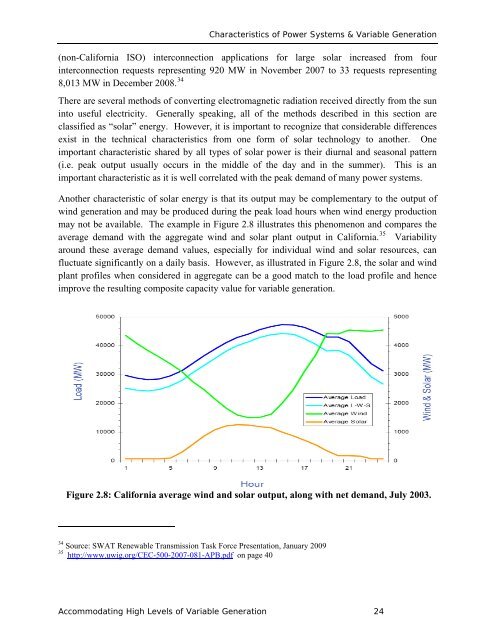Accommodating High Levels of Variable Generation - NERC
Accommodating High Levels of Variable Generation - NERC
Accommodating High Levels of Variable Generation - NERC
You also want an ePaper? Increase the reach of your titles
YUMPU automatically turns print PDFs into web optimized ePapers that Google loves.
Characteristics <strong>of</strong> Power Systems & <strong>Variable</strong> <strong>Generation</strong><br />
(non-California ISO) interconnection applications for large solar increased from four<br />
interconnection requests representing 920 MW in November 2007 to 33 requests representing<br />
8,013 MW in December 2008. 34<br />
There are several methods <strong>of</strong> converting electromagnetic radiation received directly from the sun<br />
into useful electricity. Generally speaking, all <strong>of</strong> the methods described in this section are<br />
classified as “solar” energy. However, it is important to recognize that considerable differences<br />
exist in the technical characteristics from one form <strong>of</strong> solar technology to another. One<br />
important characteristic shared by all types <strong>of</strong> solar power is their diurnal and seasonal pattern<br />
(i.e. peak output usually occurs in the middle <strong>of</strong> the day and in the summer). This is an<br />
important characteristic as it is well correlated with the peak demand <strong>of</strong> many power systems.<br />
Another characteristic <strong>of</strong> solar energy is that its output may be complementary to the output <strong>of</strong><br />
wind generation and may be produced during the peak load hours when wind energy production<br />
may not be available. The example in Figure 2.8 illustrates this phenomenon and compares the<br />
average demand with the aggregate wind and solar plant output in California. 35 Variability<br />
around these average demand values, especially for individual wind and solar resources, can<br />
fluctuate significantly on a daily basis. However, as illustrated in Figure 2.8, the solar and wind<br />
plant pr<strong>of</strong>iles when considered in aggregate can be a good match to the load pr<strong>of</strong>ile and hence<br />
improve the resulting composite capacity value for variable generation.<br />
Figure 2.8: California average wind and solar output, along with net demand, July 2003.<br />
34 Source: SWAT Renewable Transmission Task Force Presentation, January 2009<br />
35 http://www.uwig.org/CEC-500-2007-081-APB.pdf on page 40<br />
<strong>Accommodating</strong> <strong>High</strong> <strong>Levels</strong> <strong>of</strong> <strong>Variable</strong> <strong>Generation</strong> 24
















